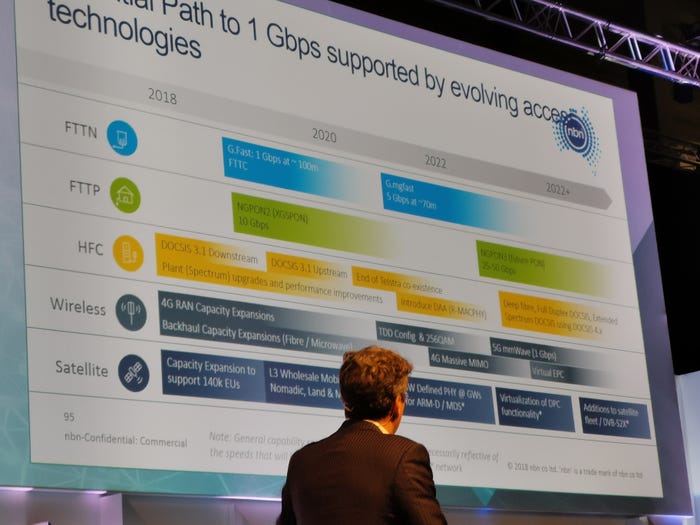NBN’s journey hasn’t been smooth, but CTO claims its delivering on the promiseNBN’s journey hasn’t been smooth, but CTO claims its delivering on the promise
At Broadband World Forum one of the most common plays was to poke fun at the NBN troubles in Australia, but CTO Ray Owen’s reckons he’s got the last laugh.
October 26, 2018

At Broadband World Forum one of the most common plays was to poke fun at the NBN troubles in Australia, but CTO Ray Owen’s reckons he’s got the last laugh.
According to Owen, the NBN network now carries 28 petabytes of data every day, with average user consuming 213 GB a month and the top 30% of fibre customers consuming more than a terabyte. Back in April, the team even noted one user managed to consumer more than 23 terabytes during the month. “We’re not too sure what he was actually doing, but he was definitely having a good time,” joked Owen.
The plan is to get 8 million happy homes on the NBN network by 2020, but also a minimum speed of 25 Mbps for all Australian citizens. In terms of penetration, Owen suggested the NBN network now services 4.4 Aussies, 63% of the target, though meeting the 25 Mbps government-mandated target would take more than fibre. A multi-technology mix has been tabled including Fixed Wireless Access (FWA), G.Fast, fibre and satellite to meet these demands. In a country the size of Australia, containing some very hostile environments, 100% fibre penetration is not a realistic goal.
Despite Owen’s claim on progress, it didn’t stop the mocking. Conference chairperson Richard Jones was one to poke fun, in between humble claims of founding 25 different companies over the course of his unassuming career, while Kate McKenzie, CEO of New Zealand wholesale network provider Chorus, revelled in the troubles as evidence of how wonderful she and her business is.
While the poking might have been on the obnoxious side, it isn’t untrue. The NBN rollout has been a painful journey, with the latest revelation coming from the latest budget estimates. CEO Steven Rue told Senate Estimates NBN would still be using the Fibre-to-the-Node (FTTN) approach until at least 2040. The multi-technology mix has been taking stick, but it is the only genuine option to ensure all Australian citizens are taking into the digital economy together. 100% fibre penetration is not going to be a viable option in the foreseeable future. That said, many of the criticisms of NBN do have merit.
Looking forward, NBN forecasts increased adoption of 4K and 8K video, smart home adoption will increase rapidly and augmented reality will start to make an impact over the next couple of years, while the business segment will continue to diversify. Real-time entertainment services are quickly declining, VPN uptake is on the up and file sharing is heading south. This will not only impact the technology which will be used to facilitate connectivity, but the approach to experience. As you can see from the picture below, the plans have been laid to evolve the network beyond the 2020 deadline.
“What I’m interested in as a CTO is the different technologies which can help improve this customer experience,” said Owen.
Beyond 2020, perhaps the full fibre (FTTP) vision will be revived. The current technology mix is best case scenario to meet demands, but it is by no means perfect or particularly future-proofed.

About the Author
You May Also Like










.png?width=300&auto=webp&quality=80&disable=upscale)


_1.jpg?width=300&auto=webp&quality=80&disable=upscale)